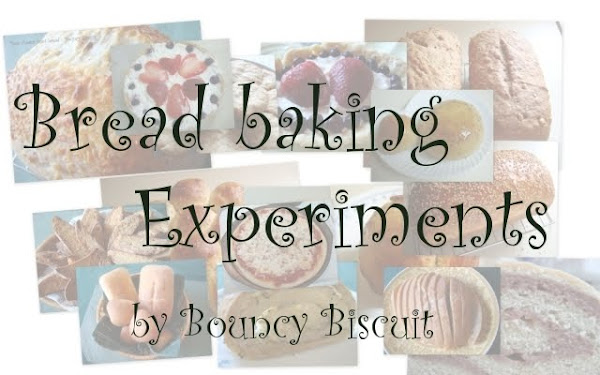Recently I was studying the science of cooking, in particular, on baking goods. Here is a summary of points I'd learnt about the purpose of various ingredients and processes in the baking of bread.
- Flour: To provide protein to develop sheets of gluten in the bread during the kneading process.
- Yeast: To produce carbon dioxide gas to rise the dough.
- Sugar: To provide food for the yeast to start its metabolism.
- Fat: To slow down the staling process after the bread comes out of oven.
- Milk: To make bread soft and to give a nice-looking crust
- Salt: For taste
- Kneading: To enable protein molecules in flour to form sheets of gluten, which trap the carbon dioxide produced by the yeast.
- Leaving to rise: to allow the yeast to metabolize to produce carbon dioxide at the temperature around 25 degrees Celsius.
- Second round of kneading and rising: to squeeze away the large gas bubbles produced in the first round of rising, and thus producing finer bubbles.
With that, I decide to try out a dill bread, from a Mennonites' cookbook called "More-with-less", from the 70s, to experiment on bread making. I want the bread to be fine and soft. Above all, I don't want it to stale too quickly, and I'd like to see a lovely crust. So I decide to use more fat, and use evaporated milk to enrich its flavor. Here is my improvised recipe.
Recipe: A Mennonite lemon dill bread (make one 5"x8" loaf or three 3"x6" loaves)
Ingredients:
Dry ingredients
- 2.5 cup all-purpose flour
- 2 teaspoons (tp) ground dill weed, dill seed, lemon peel mix
- 2 tp salt
- 1/4 tp baking soda (to neutralize the acidity for yeast to grow)
- 1 tp onion powder
- 2 tablespoon (TB) sugar
Wet ingredients
- 1 unbeaten egg
- 1 cup ricotta cheese
- 1.5 TB unsalted butter
- 2 TB margarine
- 1/4 tp sugar
- 2 tp yeast
- 1/8 cup water
- 1/8 cup evaporated milk
Procedure:
1. Melt butter and margarine.
2. Mix 1/4 tp sugar in 1/8 cup water and heat to 40 degrees Celsius. Add 1tp yeast and let the mixture sit to bubble.
3. Mix all dry ingredients and 1 tp yeast thoroughly in a large mixing bowl.
4. Mix egg, ricotta cheese, evaporated milk, melted margarine and butter in a bowl. Add this and the yeast mixture to the dry ingredients. Stir well to combine. Form a dough. Knead for 30 minutes. Add a little flour if needed to prevent sticking while kneading.
5. Cover dough with a damn cloth. Let sit in a warm dark place for 2 hours until dough doubles in size. Knead again and make a roll in a greased loaf pan (or make 3 mini loaves using mini loaf pans). Let the dough sit to rise again until it doubles in size in the pan, taking about 1-2 hours.
6. Bake at 375F about 15 minutes for mini loaves. When they are done, you'll know by the lovely aroma of herbs and butter that diffuses into the air.
I'd say this is a very good experiment. Dill and lemon make such a wonderful complement to the butter. The bread turns out soft and savory, with very fine texture and a beautiful golden crust. The bubbles are uniform and small, giving the bread lightness. The crust is done just right, after 20 minutes of cooling. Only now do I understand that the cooling part is an integral part of bread making. I added the yeast in two separate batches only because I wasn't sure if the yeast was enough. Next time I'd drop the margarine all together because it leaves a hint of sour flavor to the mouth!





